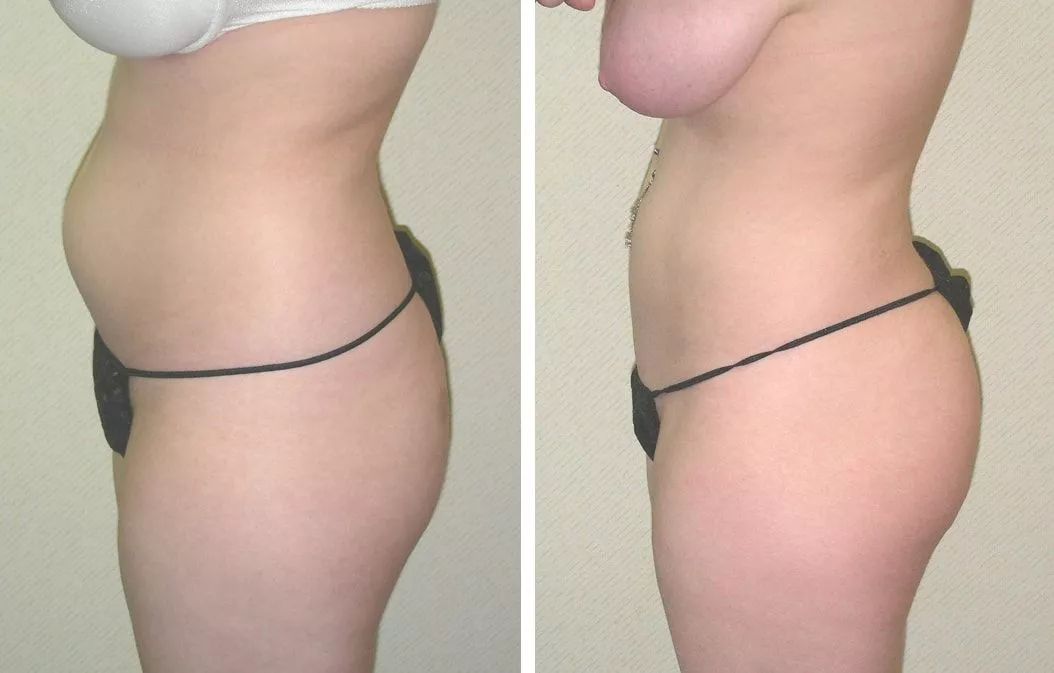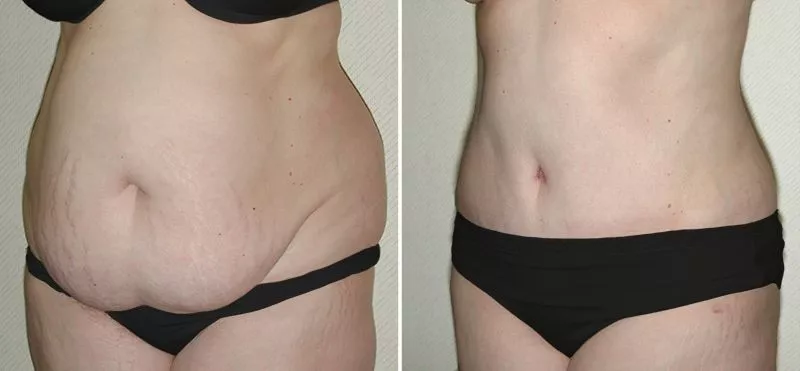Abdominal liposuction and tummy tuck surgery both result in a flatter, more shapely and attractive mid-section, but key differences separate the two.
Abdominal Liposuction
The goal of liposuction is different than that of a tummy tuck. Any liposuction is done for the express purpose of removing excess fat deposits and improving the contours of the targeted area of the body. Frequent areas addressed by liposuction are the waist, thighs, hips, buttocks, upper arms, and the abdomen.
Abdominal liposuction is the procedure used to remove excess fat in the abdominal region. Liposuction works best for patients whose skin has remained taut and elastic but have fat that has not responded to targeted exercise or weight loss.

Woman after abdominal liposuction with flatter, more defined abdomen. No tightening of her skin was necessary.
Addressing Flabby, Hanging Skin
This liposuction procedure works well for removing fat. However, this surgery but does not address the issues of flabby, hanging skin, nor the positioning of the underlying muscles. More extensive changes are best addressed with a tummy tuck.
Removing small excesses of fat from the abdomen may be performed with the tumescent liposuction procedure.There are advantages to the abdominal liposuction over tummy tuck, one of which is the type of anesthesia used. This liposuction technique can use only local anesthetic, which is often simpler for the patient. The surgery also takes less time than a tummy tuck.
When comparing abdominal liposuction and tummy tuck, the recovery for an abdominal liposuction can be quicker.
During a tumescent liposuction, your plastic surgeon will first inject the special tumescent anesthetic into the abdominal location of the fat to be treated. This anesthetizes the entire area. Additionally, the tumescent liposuction technique also restricts the blood vessels and causes the fat cells to become easier to remove.
Once the tumescent mixture takes effect, your plastic surgeon will make a very small incision in the skin. Through this tiny opening, he will insert a small, thin, tube called a cannula into the layer of fat. With a slow back and forth motion, the surgeon manipulates the cannula. This movement aids in removing the fat by means of suction through the small hole in the tube.
At the completion of the abdominal liposuction procedure, the plastic surgeon closes the incision with dissolving stitches. The surgeon or one of his team then places a compression garment around the patient’s abdomen.
The Pros and Cons of Abdominal Liposuction – Summary
Abdominal liposuction is a great procedure for removing unwanted fat in the area of the abdomen. The procedure can be performed under local anesthetic but is usually performed with sedation anesthesia and takes less time than a tummy tuck. Recovery is quicker than that after an abdominoplasty (tummy tuck).
However, an abdominal liposuction will not address loose or hanging skin and does nothing to alter the underlying muscles.
Tummy Tuck Surgery (Abdominoplasty)
When a person feels their abdomen in too large, fat, or sticks out more than it used to, it might be time for them to consider tummy tuck surgery. A tummy tuck does more than a abdominal liposuction can do. During an abdominoplasty, the plastic surgeon not only suctions off unneeded fat but also eliminates excess skin and restores weakened or separated abdominal muscles.

Woman with 4 children who had tummy tuck and liposuction of her waistline.
The goal of tummy tuck surgery is to eliminate the excess fullness while achieving the firm taut skin and abdominal muscles the person had earlier in life.
Usually, the stretched skin and muscles are caused by extreme weight fluctuations, heredity, previous surgeries, aging, or most commonly by pregnancy and childbirth.
The best candidates for a tummy tuck are at a stable weight and are healthy non-smokers. It’s best for a woman who wants a tummy tuck to wait until she is done bearing children.
Tummy Tuck Can Be Performed on Outpatient Basis
As with abdominal liposuction, a tummy tuck can be performed on an outpatient basis. However, unlike liposuction, a tummy tuck is always done with the patient under sedation or general anesthesia.
Once the anesthetic has taken effect, the plastic surgeon begins the procedure by making an incision across the abdomen, just above the pubic bone. A second incision is made to free the belly button from the surrounding tissue. From here the surgeon takes the steps necessary to complete the tummy tuck.
By the end of the surgery, the excess fat and skin will have been removed and the muscles of the abdomen will have been tightened, providing a firmer abdominal wall and a more slender waistline.
The complete procedure for a tummy tuck usually takes between two to five hours, depending on the amount of work to be done.
Recovery From Tummy Tuck Surgery
Recovery from tummy tuck surgery usually takes longer than that following abdominal liposuction. Getting better quickly must balance the need to get your body active as soon as possible with the need to rest and keep the abdomen from too much motion while it heals. Here is what you can expect after a tummy tuck procedure:
- The first few days after surgery should be quiet time. Your body needs to rest and recover. Patients should not be up and active during this time. He or she needs rest to help with healing. You can resume a normal diet as much as you feel up to it and be sure to drink plenty of fluids, especially water.
- When you leave the surgery center, you will be wearing a compression garment. The purpose of this is to diminish swelling, prevent fluid accumulations, and aid the healing process. It’s important that you don’t take off the compression garment during the first few days after your surgery. This garment helps you heal faster and influences your final surgical result.
- It’s normal to feel some pain and discomfort following your tummy tuck procedure. You will be given the right medication to help lessen this pain.
- By the 4th week following your procedure, you will be able to get back to your normal, but not physically taxing routine.
- You’ll be given more detailed instructions by your plastic surgery team before you head home.
Abdominal Liposuction and Tummy Tuck Surgery can be done in stages.
You can see there are many factors to consider when deciding between abdominal liposuction and tummy tuck. However, sometimes the best decision may be to start with an abdominal liposuction to remove the excess fat. Later we can approach the area with a tummy tuck, as needed.
The reverse is also an option. Every patient is different. The amount and location of fat and the extent to which the skin has stretched play important roles in the choice of procedure. For instance, some women who have had several children may be able to have liposuction instead of a tummy tuck. This works best if their skin has remained elastic and not overly stretched out.
This is why it’s so important when deciding on your choice of procedure, to be examined by a plastic surgeon experienced in both abdominal liposuction and tummy tuck procedures. Also, make sure he is board-certified in plastic surgery by the American Board of Medical Specialties (ABMS) and sanctioned American Board of Plastic Surgery.
Ultimately, this decision between abdominal liposuction and tummy tuck procedures is best made in consultation with your plastic surgeon. Give us a call and we would be happy to go over this decision with you.
